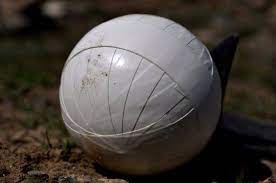
Tape Ball Cricket is exactly what the name makes it sound like. It’s a tennis ball wrapped around with tape to give it more speed and better bounce, for the game of cricket, particularly on concrete roads, where it is mostly played. What makes the game interesting and exciting is that it allows cricket players and fans, who might not have access to a cricket ball, pitch, wickets or kit, to simply buy a bat, a tennis ball and some tape, and play the game that they love most. Today in this article lets dive deeper into the world of Tape Ball cricket.
This form of cricket is said to have started in Pakistan and is still an integral part of the cricket played in their streets. Since the 1980s, tape-ball has generated a production line of fast bowlers for Pakistan who learnt to produce this kind of delivery in their teens or even earlier. It has played a huge role in the development of classy fast bowlers for Pakistan over the years. The roll call includes Wasim Akram, Waqar Younis, Shoaib Akhtar, Mohammad Sami and Umar Gul among others.
Mohammad Amir was first spotted at 13 in a local tape-ball tournament. Skills learnt from tape-ball earned Aaqib Javed a place as an opening bowler in a first-class match at the age of 12 and a Test cap at 16. Haris Rauf of Lahore Qalandars is going to be the next pace-bowling sensation in Pakistan cricket, another product of the tape-ball variety. Pakistans latest bowling sensation Shaheen Shah Afridi is yet another bowler who started his bowling career through tape Ball cricket tournaments.
Tape-ball is a tennis ball wrapped in electrical tape. This is done to make the ball smoother while the ball still remains lighter than the leather ball. When you are bowling with a heavier ball, your arm-speed is slower but when you are hurling a lighter ball at a distance, your arm-speed becomes faster. Tape Ball Cricket helps bowlers to warm up their muscles at a young age and acts as a catalyst to strengthen it for professional cricket later on.
Bowling with a tape-ball requires more effort. It puts a lot of stress on your body and helps in increasing the arm speed. A tape-ball bowler develops the understanding of angles quickly as well. The lighter ball moves in the air a lot more compared to a cricket ball and thus the bowler learns to harness the swing at an amateur age. Reverse swing is another aspect that tape-ball cricket helps you learn. It’s an important learning point, because the basic mechanism of bowling reverse swing remains the same even in international cricket – one side of the ball rough and heavier, and the other side is smooth.
There are a lot of players around the globe who intend to choose cricket as a career but are not privileged enough and this is where Tape Ball Cricket helps them make baby steps towards achieving their dream. If tape-ball acquires a national structure, a set of rules and regular television coverage, it might go on a separate path from regular cricket, not only in Pakistan, and offer a less demanding career for all the best and most dedicated players. If tape-ball takes off as a separate entity, it can go viral as a sport option for budding players.




